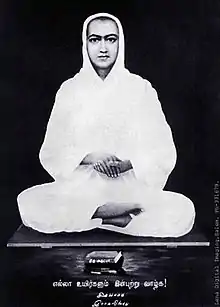Karan Kayastha is a community of Kayasthas that inhabit Orissa and the Mithila region, a region now divided between India and Nepal.[1]
Origin
According to Manu, a Hindu scripture, the Karans are regarded as bratya (degraded) Kshatriyas.[2] Other scriptural law books, such as Yajnavalkya Smrti and Amarakosha, describe them as born of a male Vaishya and female Shudra.[3]
Culture and profession
The archeologist B. P. Sinha says that the duty of Karanas was rajaseva and durgantapuraraksha.[3]
Epigraphist Dineshchandra Sircar mentions that several historial edicts and inscriptions have been found in the relevant geographic locations that show that the terms Karana, Karanin, Karaneeka, Karanakas and Karaneegars are used to represent a bureaucratic range from clerks to ministers. Significant among these are Minor Rock Edict No. II, the Kanas plates of Lokavigraha, the Ghugrahati copperplate of Samacharadeva and the Tipper copperplate of Lokanath etc.[4]
Karna of Mithila
The Karna of Mithila are called Maithil Karna Kayastha, and are mainly distributed in the Darbhanga and Madhubani districts. The community has two subgroups, namely Bhalemanush and Grihastha.[5] The Karna Kayasthas are viewed as the most pure and ancient embodiment of Mithila culture along with Maithil Brahmins. They do not fit in four varna system but still became a dominant caste of this region.[6]
Karan of Bengal
The Karan caste group can also be found in Bengal region from the mediaeval era. The Brihad-dharma and Brahma-vaivarta Puranas mentioned a caste group called Karana of mixed descent born from Vaishya father and Shudra mother, classified under the Sat-Shudra/ Uttam-Sankar-Sudra category.[7] Vaijayanti (11th century A.D.), a lexicographer, appears to consider Kayastha and Karana to be synonymous and depicts them as scribes. According to Historian Ramesh Chandra Mazumdar the Karana merged themselves into the Kayastha caste who performed the same profession like them.[8]
Karana of Odisha
The Karans held high position in Oriya society as being mentioned highly in early scriptures. They adopted the profession of writing and were merged in the Kayastha community. Sinha also mentions that the word Kayastha and Karana are often used synonymously in the scriptures of Orissa.[9] Sircar suggests that as shown in the Bhajas inscription, a list of individuals involved in land records contains a phrase 'Brahmana-Karana-Puroga-Nivasi' which may be good indication of their social status then.[4] Historian RS Sharma also mention that Loknatha, a Karana, was also referred to as a Brahmin in inscriptions, but they were ranked lower in most literature.[10] Even in the current scenario they hold good political power in Odisha including several Chief Ministers in recent years.[11]
Karanam or Sistakarnam of Andhra and Telangana
Karanam (Telugu: కరణం) or Karnam was an office and title native to the Indian states of Andhra Pradesh and Telangana. Traditionally, Karanam was an official who maintained the accounts and records of the villages and collected the taxes.[12][13] Sircar mentions that they mostly dealt with accounting, bureaucracy, teaching etc.[4]
Karuneegar of TamilNadu

Karuneegar is a caste of scribes of TamilNadu. Sircar mentions that they give great importance to mathematics so much so that one of the subcaste is named Kanakkar which literally stands for Mathematics in Tamil.[14]
References
- ↑ Sinha, Bindeshwari Prasad (2003). Kayasthas in Making of Modern Bihar. Impression Publication.
- ↑ Mandal, Mahitosh (2022). "Dalit Resistance during the Bengal Renaissance: Five Anti-Caste Thinkers from Colonial Bengal, India". CASTE: A Global Journal on Social Exclusion. 3 (1): 11–30. doi:10.26812/caste.v3i1.367. ISSN 2639-4928. JSTOR 48674170. S2CID 249027627.
- 1 2 Sinha, Bindeshwari Prasad (2003). Kayasthas in Making of Modern Bihar. Impression Publication.
- 1 2 3 Sircar, Dineshchandra (1960–61). Epigraphia Indica- Volume XXXIV. Delhi: Archaeological Survey Of India.
- ↑ Singh, Kumar Suresh (1998). People of India: India's communities. Oxford University Press. ISBN 978-0-19-563354-2.
- ↑ Chatterji, Roma (1 December 2014). Wording the World: Veena Das and Scenes of Inheritance. Fordham Univ Press. ISBN 978-0-8232-6187-1.
- ↑ Harlan, Lindsey; Courtright, Paul B. (1995). From the Margins of Hindu Marriage. Oxford University Press. pp. 146, 148. ISBN 978-0-19-508118-3.
- ↑ MAJUMDAR, R. C. (1971). HISTORY OF ANCIENT BENGAL. G. BHARADWAJ , CALCUTTA.
- ↑ Sinha, Bindeshwari Prasad (2003). Kayasthas in Making of Modern Bihar. Impression Publication.
- ↑ Sharma, RS (2001). Early Medieval Indian Society. Orient Longman.
- ↑ Singh, Pradeep (2020). Urban Ecology: Emerging Patterns and Social-Ecological Systems. Elsevier Science.
- ↑ Community Development and Panchayati Raj Digest, Volumes 3-5. National Institute of Community Development. 1971. p. 334.
Patwari / Karanam shall be the additional secretary to the gram panchayat for keeping the record concerning lands
- ↑ Andhra Pradesh District Gazetteers. Government of Andhra Pradesh. 2000. pp. 185, 186.
- ↑ Sircar, Dineshchandra (1960–61). Epigraphia Indica- Volume XXXIV. Delhi: Archaeological Survey Of India.